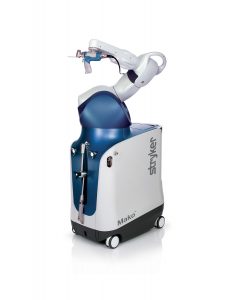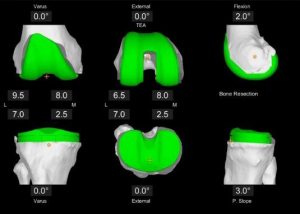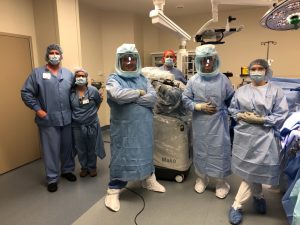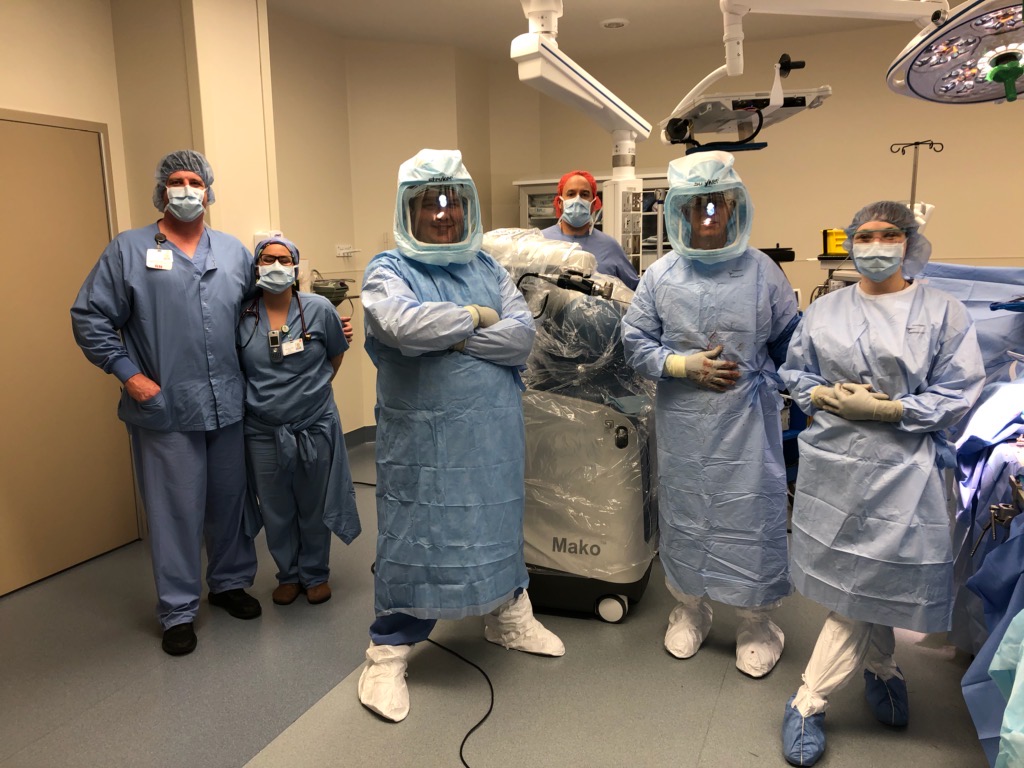To understand the newest service being offered at Olympia Orthopaedic Associates (OOA), it’s important to realize what it is not. Misconceptions abound regarding robotic-assisted surgery, says Dr. Darrin Trask, who has been trained on how to use MAKO robots for total hip and knee replacements. “People think this is a new surgery, but a knee replacement is still a knee replacement,” he explains. “The robot allows me to prepare the patient’s bone in a much more precise way to get the knee replacement implants in an optimal position.” Starting in 2020, OOA patients undergoing total joint replacements will have the option of robotic-assisted surgery.

MAKO surgical robots were developed in 2004 and their use has continued to grow within the orthopedic industry. Today, orthopedic surgeons are routinely trained on them as part of their residency. Several are in use in Portland and Seattle, says Dr. Trask, but this is the first one in Thurston County. “Normally it’s something we see in large metropolitan areas but more surgeons in smaller communities are starting to adopt this technology as they see the value of it,” he explains.
Capitol Medical Center (CMC) purchased the MAKO robot and Dr. Trask has operating privileges there, allowing him to offer the robotic-assisted option to OOA patients. He credits the CMC team with having the foresight to invest in technology that shows no sign of going away. “When all the major joint replacement implant manufacturers are pushing for and developing robotic platforms, that gives you a clue as to where the field is going,” he notes.
Using the robot creates a greater level of precision for placing implants by mapping each patient’s anatomy before a single cut is made. The software creates a real-time image of the knee or hip and greatly reduces any surprises in the surgical process. “I’m able to plan the patient’s case before I’ve committed to any cuts that dictate implant placement,” says Dr. Trask. “I have a very good idea of how their knee or hip is going to behave. I’ve done the surgery virtually before I begin in reality.”
In traditional knee replacements, the surgeon needs to adjust to what they find as the surgery proceeds. For example, if some part of the joint is looser than expected the doctor might use a thicker plastic implant and release a bit more soft tissue to create greater balance. The goal is to create the best balance possible, which provides the most stability and greatest range of motion. The more precisely implants are placed, the greater the balance.

“I get so much more information from the robot that I can use to get patients a more natural feeling knee or hip replacement,” says Dr. Trask. “My analogy is, I know where Century Link stadium is but if I plug it into my navigation, Google is smart enough to tell me that there’s a traffic jam ahead, or that there’s a road closed. It’s going to get me there in the most efficient way possible. I think that’s a fair way to characterize the robot.”
Some patients confuse the MAKO with other surgical robots such as the Da Vinci, which do not require surgeons to be scrubbed in. The MAKO looks more like an industrial robotic arm with a saw or reamer attached at the end. “I have to physically be running it, just like I would be operating a saw or reamer in a manual total joint replacement,” says Dr. Trask.
Because the robot uses haptics (technology that can create an experience of touch by applying forces, vibrations or motions to the user), it will actually shut itself off if the surgeon attempts to make any cuts that aren’t predetermined by the software. “I think the haptic technology adds a level of safety to the procedure,” Dr. Trask notes. “It is much more difficult to injury a structure via human error.”

After just two years of robotic-assisted total knee replacements and five years of total hip replacements, Dr. Trask doesn’t yet have long-term data on the relative longevity of implants placed with robotic assistance, but he suspects they will last longer than their traditionally-placed counterparts. “There are studies that show when implants are better aligned, they survive longer,” he says. “If I have something that can tighten my curve that consistently gets parts better aligned for that patient, I think that gives them the best chance of a good outcome going forward.”
OOA completed the credentialing process to use the MAKO surgical robot in December 2019 and will begin offering robotically-assisted joint replacements in January 2020.
Learn more by visiting the Olympia Orthopaedic Associates website or calling 360.709.6230.
Sponsored



















































